FIAT TALENTO 2017 Owner handbook (in English)
Manufacturer: FIAT, Model Year: 2017, Model line: TALENTO, Model: FIAT TALENTO 2017Pages: 228, PDF Size: 4.47 MB
Page 161 of 228
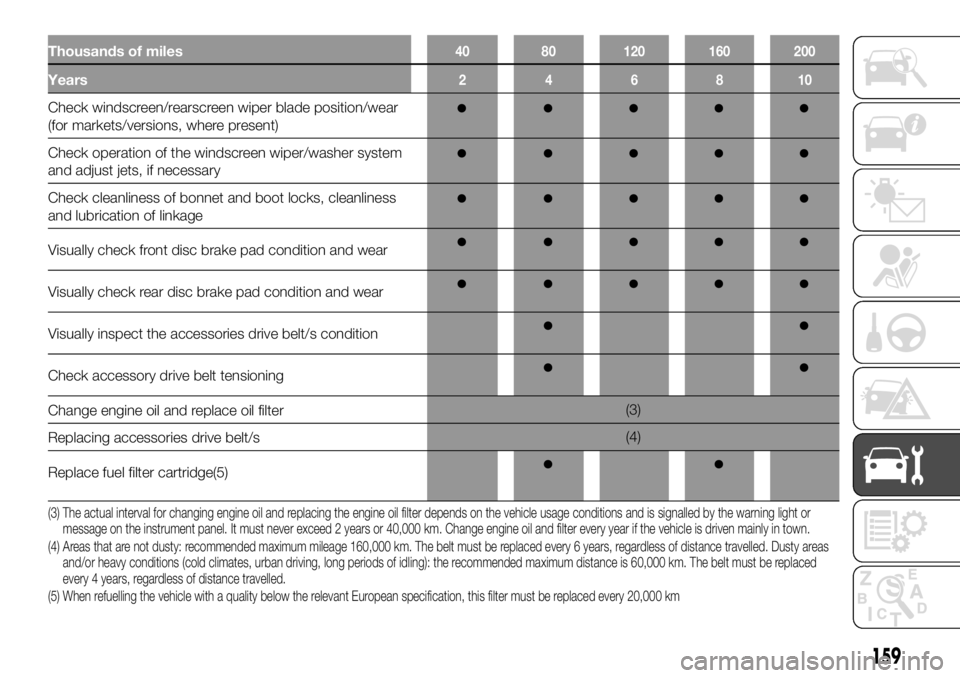
Thousands of miles40 80 120 160 200
Years246810
Check windscreen/rearscreen wiper blade position/wear
(for markets/versions, where present)
Check operation of the windscreen wiper/washer system
and adjust jets, if necessary
Check cleanliness of bonnet and boot locks, cleanliness
and lubrication of linkage
Visually check front disc brake pad condition and wear
Visually check rear disc brake pad condition and wear
Visually inspect the accessories drive belt/s condition
Check accessory drive belt tensioning
Change engine oil and replace oil filter(3)
Replacing accessories drive belt/s(4)
Replace fuel filter cartridge(5)
(3) The actual interval for changing engine oil and replacing the engine oil filter depends on the vehicle usage conditions and is signalled by the warning light or
message on the instrument panel. It must never exceed 2 years or 40,000 km. Change engine oil and filter every year if the vehicle is driven mainly in town.
(4) Areas that are not dusty: recommended maximum mileage 160,000 km. The belt must be replaced every 6 years, regardless of distance travelled. Dustyareas
and/or heavy conditions (cold climates, urban driving, long periods of idling): the recommended maximum distance is 60,000 km. The belt must be replaced
every 4 years, regardless of distance travelled.
(5) When refuelling the vehicle with a quality below the relevant European specification, this filter must be replaced every 20,000 km
159
Page 162 of 228
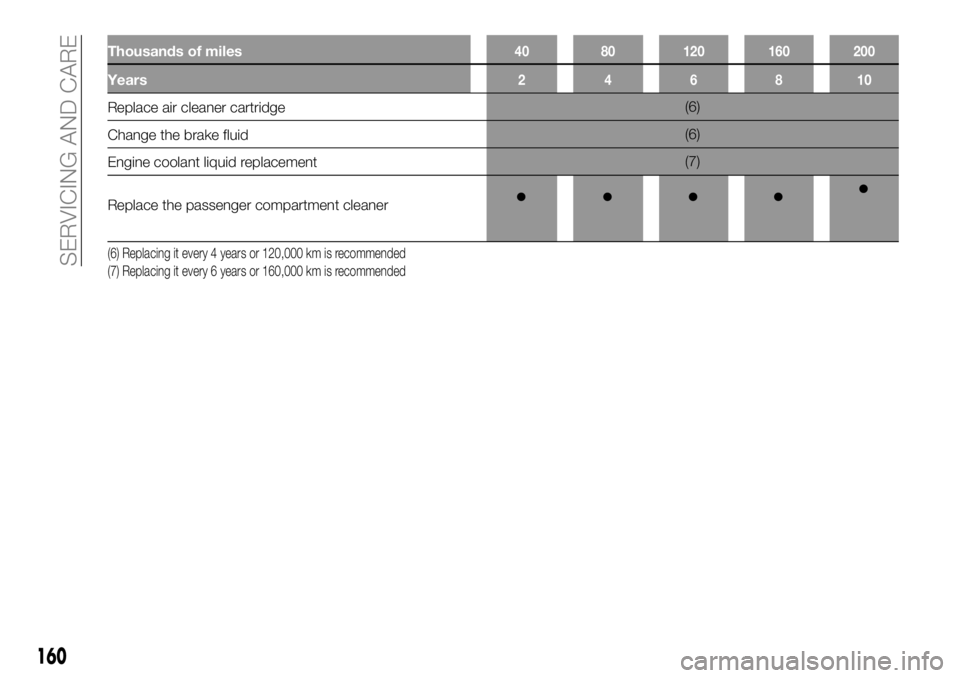
Thousands of miles40 80 120 160 200
Years246810
Replace air cleaner cartridge(6)
Change the brake fluid(6)
Engine coolant liquid replacement(7)
Replace the passenger compartment cleaner
(6) Replacing it every 4 years or 120,000 km is recommended
(7) Replacing it every 6 years or 160,000 km is recommended
160
SERVICING AND CARE
Page 163 of 228
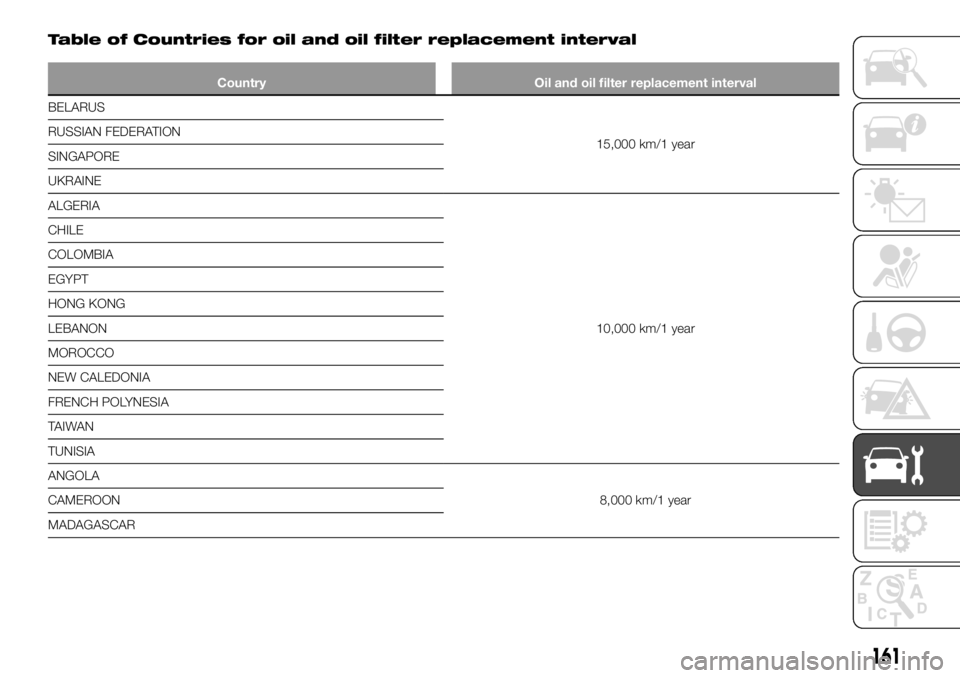
Table of Countries for oil and oil filter replacement interval
Country Oil and oil filter replacement interval
BELARUS
15,000
km/1 year RUSSIAN FEDERATION
SINGAPORE
UKRAINE
ALGERIA
10,000 km/1 year CHILE
COLOMBIA
EGYPT
HONG KONG
LEBANON
MOROCCO
NEW CALEDONIA
FRENCH POLYNESIA
TAIWAN
TUNISIA
ANGOLA
8,000 km/1 year CAMEROON
MADAGASCAR
161
Page 164 of 228
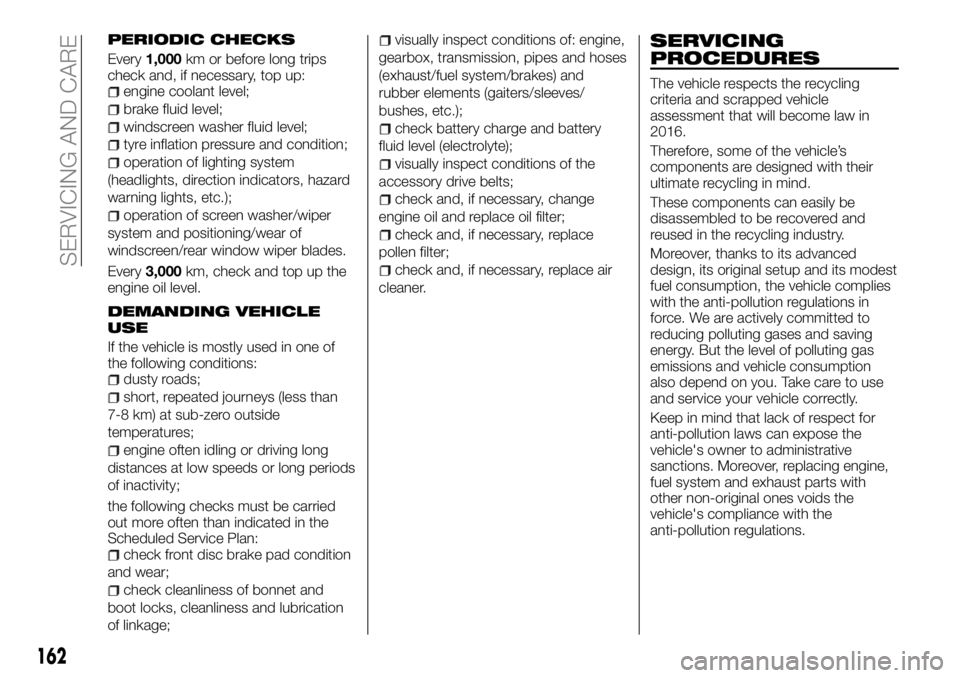
PERIODIC CHECKS
Every1,000km or before long trips
check and, if necessary, top up:
engine coolant level;
brake fluid level;
windscreen washer fluid level;
tyre inflation pressure and condition;
operation of lighting system
(headlights, direction indicators, hazard
warning lights, etc.);
operation of screen washer/wiper
system and positioning/wear of
windscreen/rear window wiper blades.
Every3,000km, check and top up the
engine oil level.
DEMANDING VEHICLE
USE
If the vehicle is mostly used in one of
the following conditions:
dusty roads;
short, repeated journeys (less than
7-8 km) at sub-zero outside
temperatures;
engine often idling or driving long
distances at low speeds or long periods
of inactivity;
the following checks must be carried
out more often than indicated in the
Scheduled Service Plan:
check front disc brake pad condition
and wear;
check cleanliness of bonnet and
boot locks, cleanliness and lubrication
of linkage;
visually inspect conditions of: engine,
gearbox, transmission, pipes and hoses
(exhaust/fuel system/brakes) and
rubber elements (gaiters/sleeves/
bushes, etc.);
check battery charge and battery
fluid level (electrolyte);
visually inspect conditions of the
accessory drive belts;
check and, if necessary, change
engine oil and replace oil filter;
check and, if necessary, replace
pollen filter;
check and, if necessary, replace air
cleaner.
SERVICING
PROCEDURES
The vehicle respects the recycling
criteria and scrapped vehicle
assessment that will become law in
2016.
Therefore, some of the vehicle’s
components are designed with their
ultimate recycling in mind.
These components can easily be
disassembled to be recovered and
reused in the recycling industry.
Moreover, thanks to its advanced
design, its original setup and its modest
fuel consumption, the vehicle complies
with the anti-pollution regulations in
force. We are actively committed to
reducing polluting gases and saving
energy. But the level of polluting gas
emissions and vehicle consumption
also depend on you. Take care to use
and service your vehicle correctly.
Keep in mind that lack of respect for
anti-pollution laws can expose the
vehicle's owner to administrative
sanctions. Moreover, replacing engine,
fuel system and exhaust parts with
other non-original ones voids the
vehicle's compliance with the
anti-pollution regulations.
162
SERVICING AND CARE
Page 165 of 228
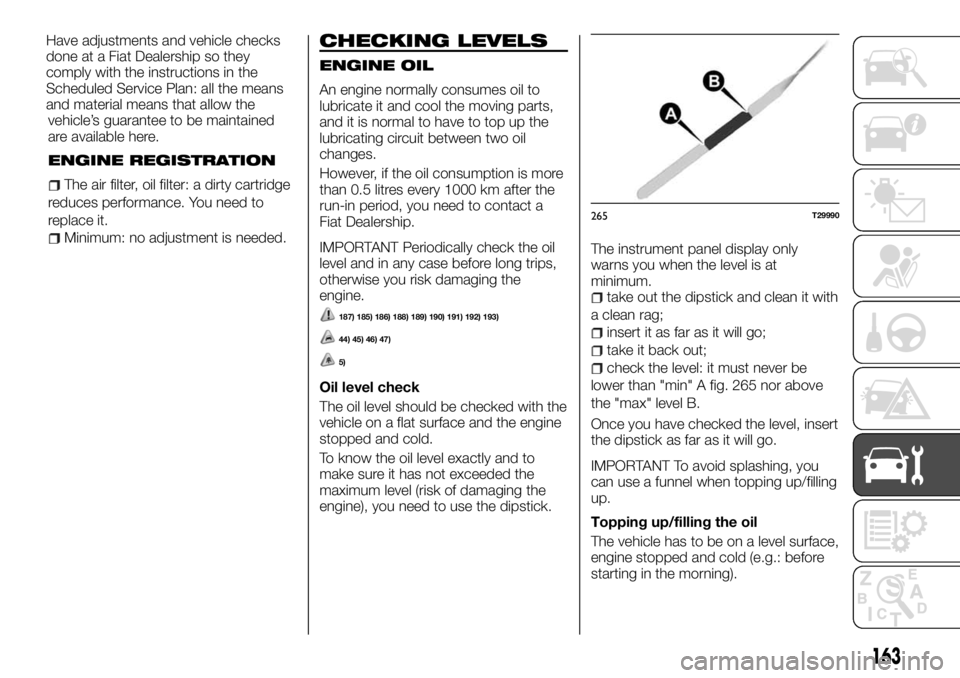
vehicle’s guarantee to be maintained
are available here.
ENGINE REGISTRATION
The air filter, oil filter: a dirty cartridge
reduces performance. You need to
replace it.
Minimum: no adjustment is needed.
CHECKING LEVELS
ENGINE OIL
An engine normally consumes oil to
lubricate it and cool the moving parts,
and it is normal to have to top up the
lubricating circuit between two oil
changes.
However, if the oil consumption is more
than 0.5 litres every 1000 km after the
run-in period, you need to contact a
Fiat Dealership.
IMPORTANT Periodically check the oil
level and in any case before long trips,
otherwise you risk damaging the
engine.
187) 185) 186) 188) 189) 190) 191) 192) 193)
44) 45) 46) 47)
5)
Oil level check
The oil level should be checked with the
vehicle on a flat surface and the engine
stopped and cold.
To know the oil level exactly and to
make sure it has not exceeded the
maximum level (risk of damaging the
engine), you need to use the dipstick.The instrument panel display only
warns you when the level is at
minimum.
take out the dipstick and clean it with
a clean rag;
insert it as far as it will go;
take it back out;
check the level: it must never be
lower than "min" A fig. 265 nor above
the "max" level B.
Once you have checked the level, insert
the dipstick as far as it will go.
IMPORTANT To avoid splashing, you
can use a funnel when topping up/filling
up.
Topping up/filling the oil
The vehicle has to be on a level surface,
engine stopped and cold (e.g.: before
starting in the morning).
265T29990
163
Have adjustments and vehicle checks
done at a Fiat Dealership so they
comply with the instructions in the
Scheduled Service Plan: all the means
and material means that allow the
Page 166 of 228
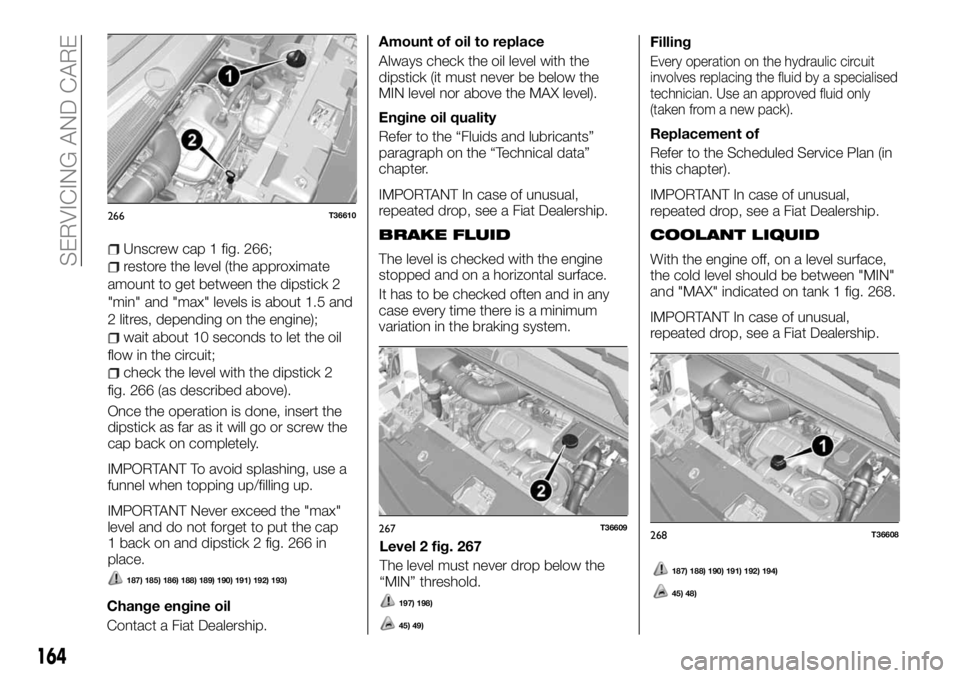
Unscrew cap 1 fig. 266;
restore the level (the approximate
amount to get between the dipstick 2
"min" and "max" levels is about 1.5 and
2 litres, depending on the engine);
wait about 10 seconds to let the oil
flow in the circuit;
check the level with the dipstick 2
fig. 266 (as described above).
Once the operation is done, insert the
dipstick as far as it will go or screw the
cap back on completely.
IMPORTANT To avoid splashing, use a
funnel when topping up/filling up.
IMPORTANT Never exceed the "max"
level and do not forget to put the cap
1 back on and dipstick 2 fig. 266 in
place.
187) 185) 186) 188) 189) 190) 191) 192) 193)
Change engine oil
Contact a Fiat Dealership.Amount of oil to replace
Always check the oil level with the
dipstick (it must never be below the
MIN level nor above the MAX level).
Engine oil quality
Refer to the “Fluids and lubricants”
paragraph on the “Technical data”
chapter.
IMPORTANT In case of unusual,
repeated drop, see a Fiat Dealership.
BRAKE FLUID
The level is checked with the engine
stopped and on a horizontal surface.
It has to be checked often and in any
case every time there is a minimum
variation in the braking system.
Level 2 fig. 267
The level must never drop below the
“MIN” threshold.
197) 198)
45) 49)
Filling
Every operation on the hydraulic circuit
involves replacing the fluid by a specialised
technician. Use an approved fluid only
(taken from a new pack).
Replacement of
Refer to the Scheduled Service Plan (in
this chapter).
IMPORTANT In case of unusual,
repeated drop, see a Fiat Dealership.
COOLANT LIQUID
With the engine off, on a level surface,
the cold level should be between "MIN"
and "MAX" indicated on tank 1 fig. 268.
IMPORTANT In case of unusual,
repeated drop, see a Fiat Dealership.
266T36610
267T36609268T36608
164
SERVICING AND CARE
187) 188) 190) 191) 192) 194)
45) 48)
Page 167 of 228
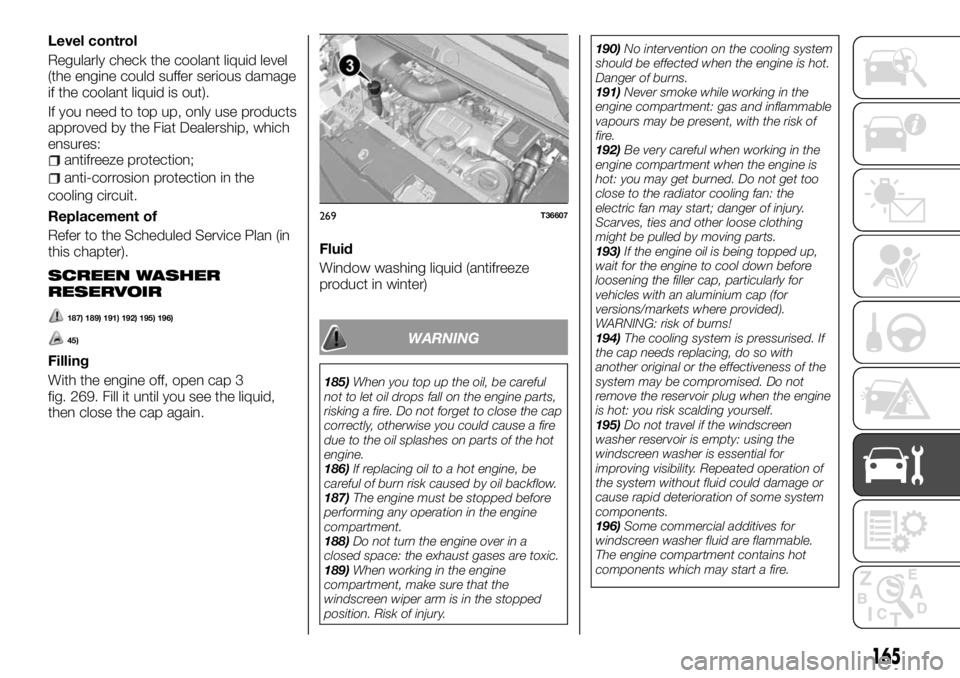
Level control
Regularly check the coolant liquid level
(the engine could suffer serious damage
if the coolant liquid is out).
If you need to top up, only use products
approved by the Fiat Dealership, which
ensures:
antifreeze protection;
anti-corrosion protection in the
cooling circuit.
Replacement of
Refer to the Scheduled Service Plan (in
this chapter).
SCREEN WASHER
RESERVOIR
187) 189) 191) 192) 195) 196)
45)
Filling
With the engine off, open cap 3
fig. 269. Fill it until you see the liquid,
then close the cap again.Fluid
Window washing liquid (antifreeze
product in winter)
WARNING
185)When you top up the oil, be careful
not to let oil drops fall on the engine parts,
risking a fire. Do not forget to close the cap
correctly, otherwise you could cause a fire
due to the oil splashes on parts of the hot
engine.
186)If replacing oil to a hot engine, be
careful of burn risk caused by oil backflow.
187)The engine must be stopped before
performing any operation in the engine
compartment.
188)Do not turn the engine over in a
closed space: the exhaust gases are toxic.
189)When working in the engine
compartment, make sure that the
windscreen wiper arm is in the stopped
position. Risk of injury.190)No intervention on the cooling system
should be effected when the engine is hot.
Danger of burns.
191)Never smoke while working in the
engine compartment: gas and inflammable
vapours may be present, with the risk of
fire.
192)Be very careful when working in the
engine compartment when the engine is
hot: you may get burned. Do not get too
close to the radiator cooling fan: the
electric fan may start; danger of injury.
Scarves, ties and other loose clothing
might be pulled by moving parts.
193)If the engine oil is being topped up,
wait for the engine to cool down before
loosening the filler cap, particularly for
vehicles with an aluminium cap (for
versions/markets where provided).
WARNING: risk of burns!
194)The cooling system is pressurised. If
the cap needs replacing, do so with
another original or the effectiveness of the
system may be compromised. Do not
remove the reservoir plug when the engine
is hot: you risk scalding yourself.
195)Do not travel if the windscreen
washer reservoir is empty: using the
windscreen washer is essential for
improving visibility. Repeated operation of
the system without fluid could damage or
cause rapid deterioration of some system
components.
196)Some commercial additives for
windscreen washer fluid are flammable.
The engine compartment contains hot
components which may start a fire.
269T36607
165
Page 168 of 228
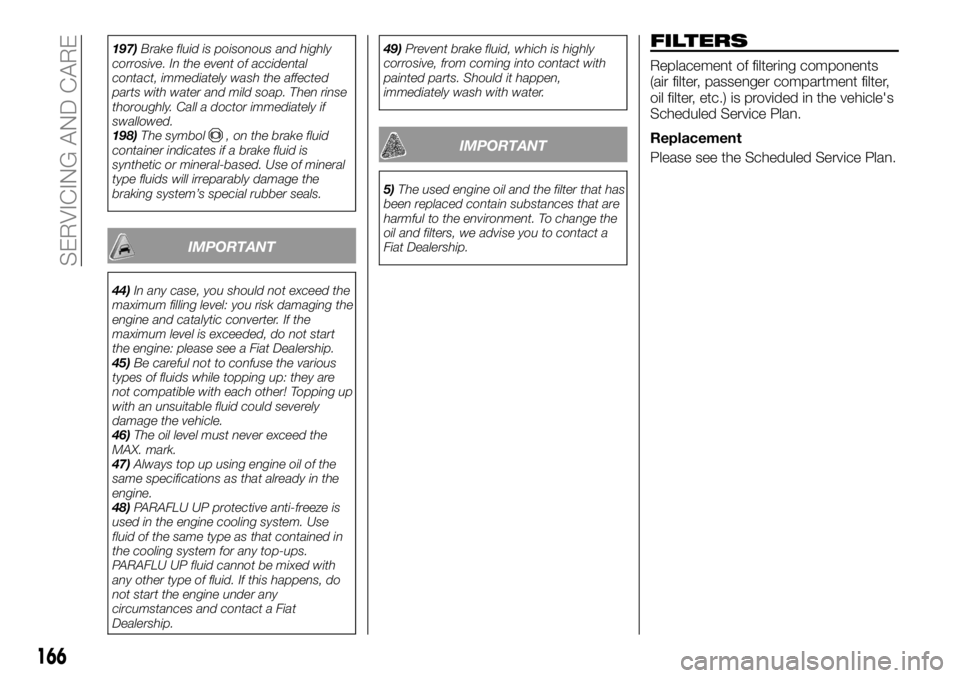
197)Brake fluid is poisonous and highly
corrosive. In the event of accidental
contact, immediately wash the affected
parts with water and mild soap. Then rinse
thoroughly. Call a doctor immediately if
swallowed.
198)The symbol
, on the brake fluid
container indicates if a brake fluid is
synthetic or mineral-based. Use of mineral
type fluids will irreparably damage the
braking system’s special rubber seals.
IMPORTANT
44)In any case, you should not exceed the
maximum filling level: you risk damaging the
engine and catalytic converter. If the
maximum level is exceeded, do not start
the engine: please see a Fiat Dealership.
45)Be careful not to confuse the various
types of fluids while topping up: they are
not compatible with each other! Topping up
with an unsuitable fluid could severely
damage the vehicle.
46)The oil level must never exceed the
MAX. mark.
47)Always top up using engine oil of the
same specifications as that already in the
engine.
48)PARAFLU UP protective anti-freeze is
used in the engine cooling system. Use
fluid of the same type as that contained in
the cooling system for any top-ups.
PARAFLU UP fluid cannot be mixed with
any other type of fluid. If this happens, do
not start the engine under any
circumstances and contact a Fiat
Dealership.49)Prevent brake fluid, which is highly
corrosive, from coming into contact with
painted parts. Should it happen,
immediately wash with water.
IMPORTANT
5)The used engine oil and the filter that has
been replaced contain substances that are
harmful to the environment. To change the
oil and filters, we advise you to contact a
Fiat Dealership.
FILTERS
Replacement of filtering components
(air filter, passenger compartment filter,
oil filter, etc.) is provided in the vehicle's
Scheduled Service Plan.
Replacement
Please see the Scheduled Service Plan.
166
SERVICING AND CARE
Page 169 of 228
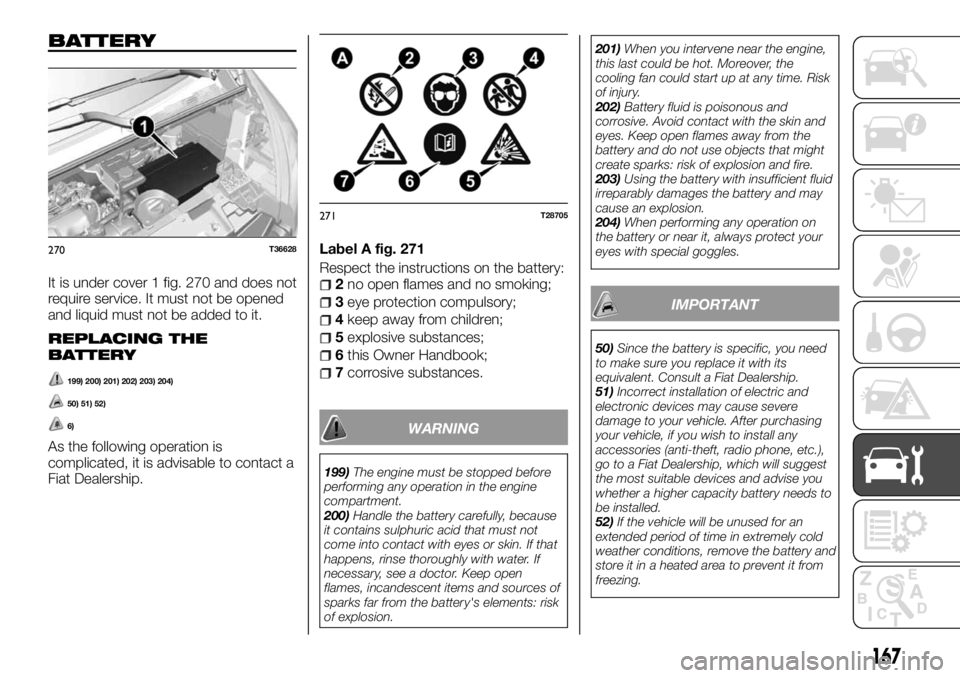
BATTERY
It is under cover 1 fig. 270 and does not
require service. It must not be opened
and liquid must not be added to it.
REPLACING THE
BATTERY
199) 200) 201) 202) 203) 204)
50) 51) 52)
6)
As the following operation is
complicated, it is advisable to contact a
Fiat Dealership.Label A fig. 271
Respect the instructions on the battery:
2no open flames and no smoking;
3eye protection compulsory;
4keep away from children;
5explosive substances;
6this Owner Handbook;
7corrosive substances.
WARNING
199)The engine must be stopped before
performing any operation in the engine
compartment.
200)Handle the battery carefully, because
it contains sulphuric acid that must not
come into contact with eyes or skin. If that
happens, rinse thoroughly with water. If
necessary, see a doctor. Keep open
flames, incandescent items and sources of
sparks far from the battery's elements: risk
of explosion.201)When you intervene near the engine,
this last could be hot. Moreover, the
cooling fan could start up at any time. Risk
of injury.
202)Battery fluid is poisonous and
corrosive. Avoid contact with the skin and
eyes. Keep open flames away from the
battery and do not use objects that might
create sparks: risk of explosion and fire.
203)Using the battery with insufficient fluid
irreparably damages the battery and may
cause an explosion.
204)When performing any operation on
the battery or near it, always protect your
eyes with special goggles.
IMPORTANT
50)Since the battery is specific, you need
to make sure you replace it with its
equivalent. Consult a Fiat Dealership.
51)Incorrect installation of electric and
electronic devices may cause severe
damage to your vehicle. After purchasing
your vehicle, if you wish to install any
accessories (anti-theft, radio phone, etc.),
go to a Fiat Dealership, which will suggest
the most suitable devices and advise you
whether a higher capacity battery needs to
be installed.
52)If the vehicle will be unused for an
extended period of time in extremely cold
weather conditions, remove the battery and
store it in a heated area to prevent it from
freezing.
270T36628
271T28705
167
Page 170 of 228
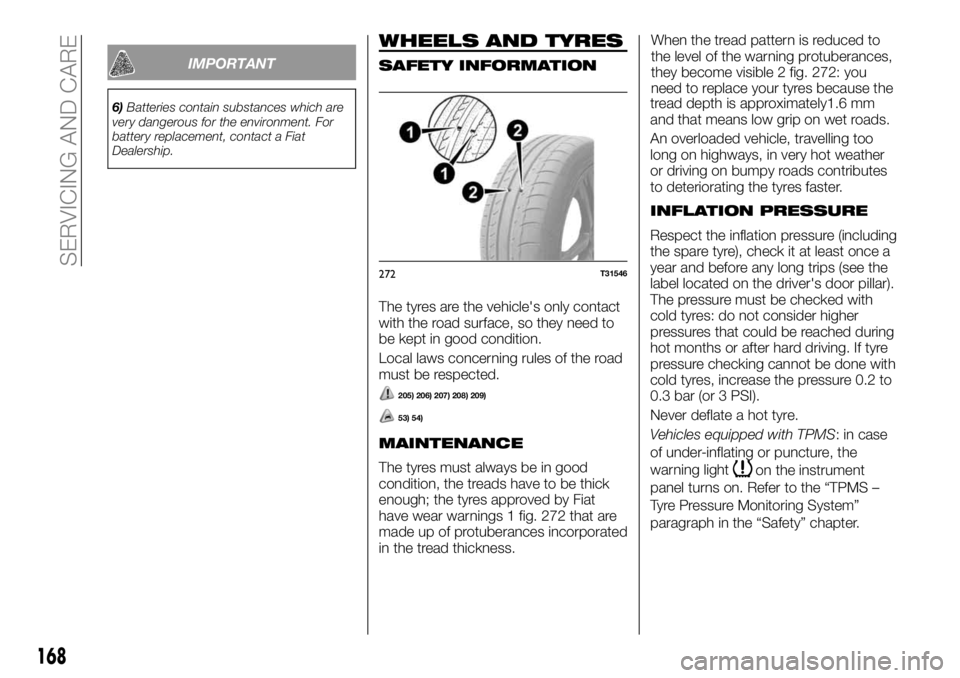
IMPORTANT
6)Batteries contain substances which are
very dangerous for the environment. For
battery replacement, contact a Fiat
Dealership.
WHEELS AND TYRES
SAFETY INFORMATION
The tyres are the vehicle's only contact
with the road surface, so they need to
be kept in good condition.
Local laws concerning rules of the road
must be respected.
205) 206) 207) 208) 209)
53) 54)
MAINTENANCE
The tyres must always be in good
condition, the treads have to be thick
enough; the tyres approved by Fiat
have wear warnings 1 fig. 272 that are
made up of protuberances incorporated
in the tread thickness.When the tread pattern is reduced to
the level of the warning protuberances,
they become visible 2 fig. 272: you
need to replace your tyres because the
tread depth is approximately1.6 mm
and that means low grip on wet roads.
An overloaded vehicle, travelling too
long on highways, in very hot weather
or driving on bumpy roads contributes
to deteriorating the tyres faster.
INFLATION PRESSURE
Respect the inflation pressure (including
the spare tyre), check it at least once a
year and before any long trips (see the
label located on the driver's door pillar).
The pressure must be checked with
cold tyres: do not consider higher
pressures that could be reached during
hot months or after hard driving. If tyre
pressure checking cannot be done with
cold tyres, increase the pressure 0.2 to
0.3 bar (or 3 PSI).
Never deflate a hot tyre.
Vehicles equipped with TPMS: in case
of under-inflating or puncture, the
warning light
on the instrument
panel turns on. Refer to the “TPMS –
Tyre Pressure Monitoring System”
paragraph in the “Safety” chapter.
272T31546
168
SERVICING AND CARE